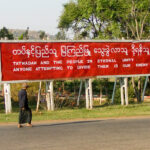This analysis was featured in Critical State, a weekly newsletter from Inkstick Media and The World. Subscribe here.
Only part of a nation ever goes to war. Even the total wars that typified the first half of the 20th century — conflicts seen as existential for all participants and involving a wholesale mobilization of people and industry — only pulled in a fraction of the population as combatants. For multiethnic countries, especially ones where legal regimes create imbalance and racialized societies, the way that burden falls unevenly can lead to large disparities in how the component populations within the nation feel about war.
In “Whose War is it Anyway? Explaining the Black-White Gap in Support for the Use of Force Abroad,” authors Naima Green-Riley and Andrew Leber document a “race gap” in enthusiasm for US wars between Black and white Americans. The effect of this gap is persistent and greater than can be explained by other factors, like family in the military or political alienation.
“Whereas long-standing observations of a ‘gender gap’ in support for war have given rise to an extensive research program — and amid a growing acceptance of the role of mass attitudes in shaping foreign policy decision making — examinations of race and ethnicity in IR have been largely confined to the study of ethnic conflict and civil war,” write the authors. “This is striking. The results from decades of social science research on the use of force abroad show significantly different levels of support for war between Black and White respondents in the United States, with Black respondents expressing much less enthusiasm for US military extroversion. Across myriad conflicts, time periods, and geographical regions in the United States, the ‘race gap’ in support for the use of force has surfaced repeatedly. Although Black support for war has fluctuated across conflicts, the gap persists.”
“Across myriad conflicts, time periods, and geographical regions in the United States, the ‘race gap’ in support for the use of force has surfaced repeatedly,” write Green-Riley and Leber.
Part of this, the authors find, is the legacy of past military organization in the United States, where the military was officially segregated through World War II and in parts into the Korean War.
But it also, the authors argue, comes from “linked fate,” or “an individual-level concern for the improvement of social and economic conditions for all members of the race.” The authors describe “linked fate” as a key source of Black Americans’ relatively unified political and policy views, which isn’t always concerned with the entire nation.
The attitudes of Black Americans from the Korean War through the Vietnam and Iraq wars are good examples of linked fate because each of these wars was seen as particularly risky for Black Americans, and in turn, less worth that sacrifice.
According to the authors, “Imbalanced casualty numbers at the beginning of the Vietnam War exacerbated linked fate concerns about casualties among Black Americans, but these sociotropic concerns also existed before Vietnam, even in contexts where Black and White casualties were more evenly distributed. For instance, the rates of war deaths between Black and White soldiers were comparable both before and after desegregation of US forces in the Korean War. Nevertheless, because of troop segregation at the beginning of that war, the perception of Black American activists at the time was that Black soldiers faced greater risk of death in Korea due to White officers’ racism.”
In other words, the “race gap” has serious implications for how Americans of color view military service and the sacrifice associated with serving in the armed forces, and foreign policy in general.




















